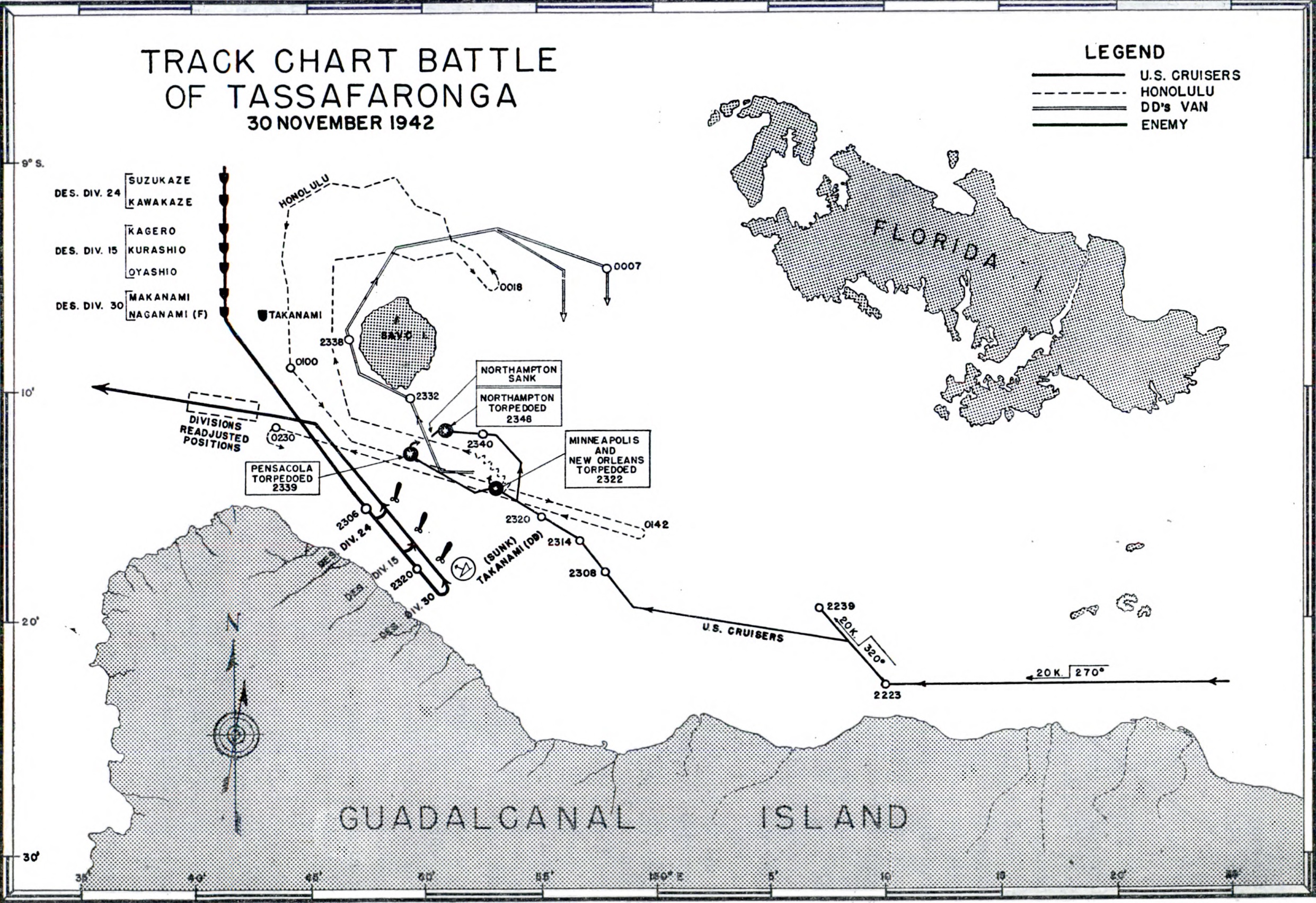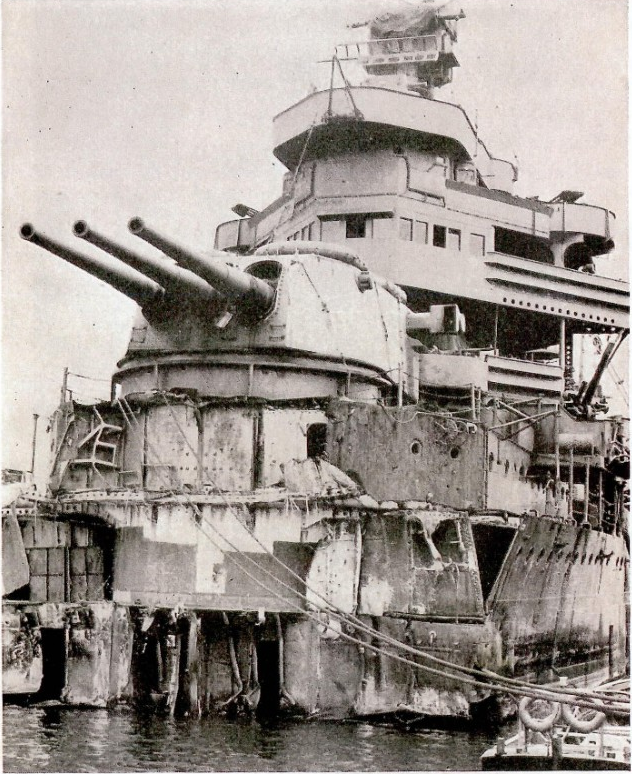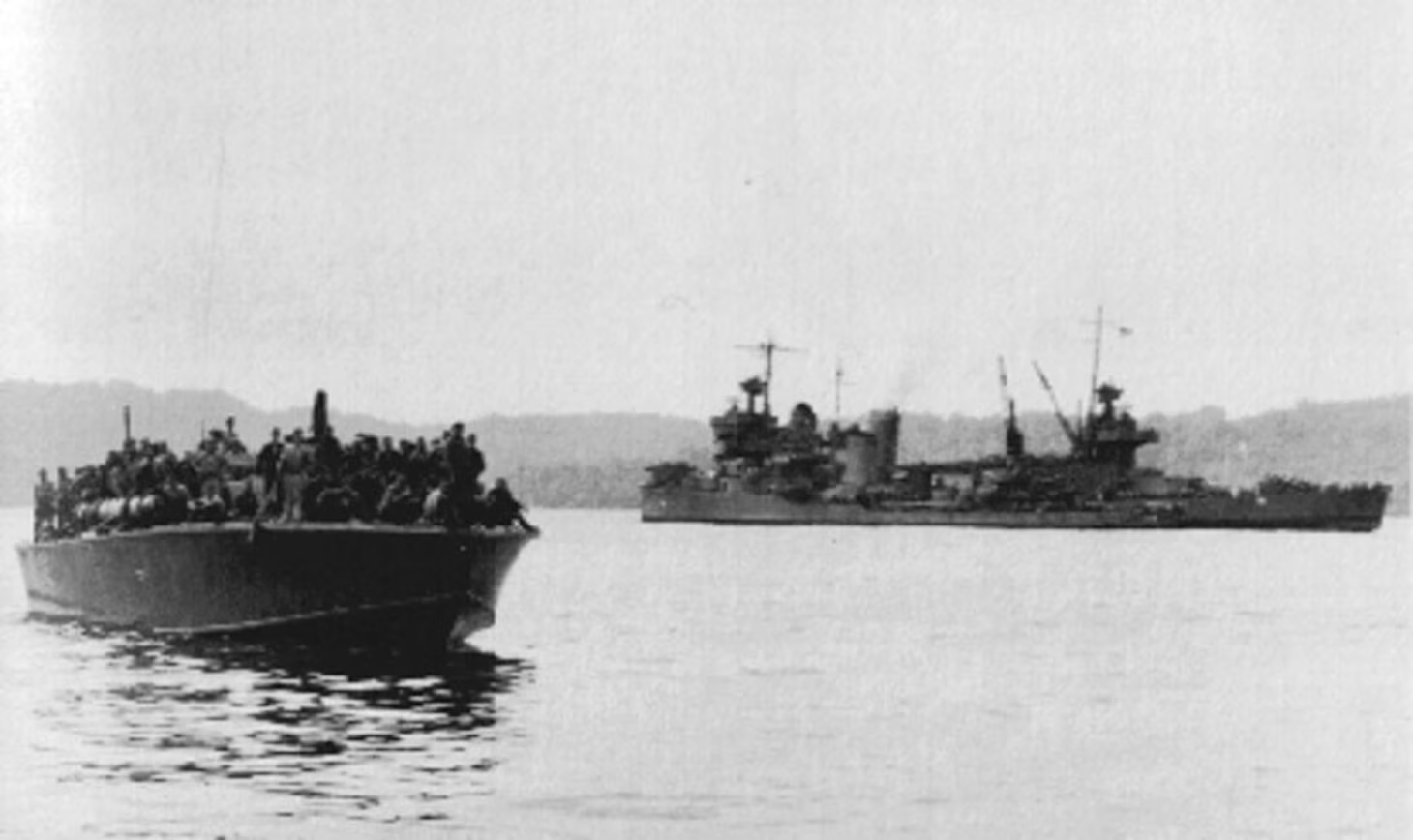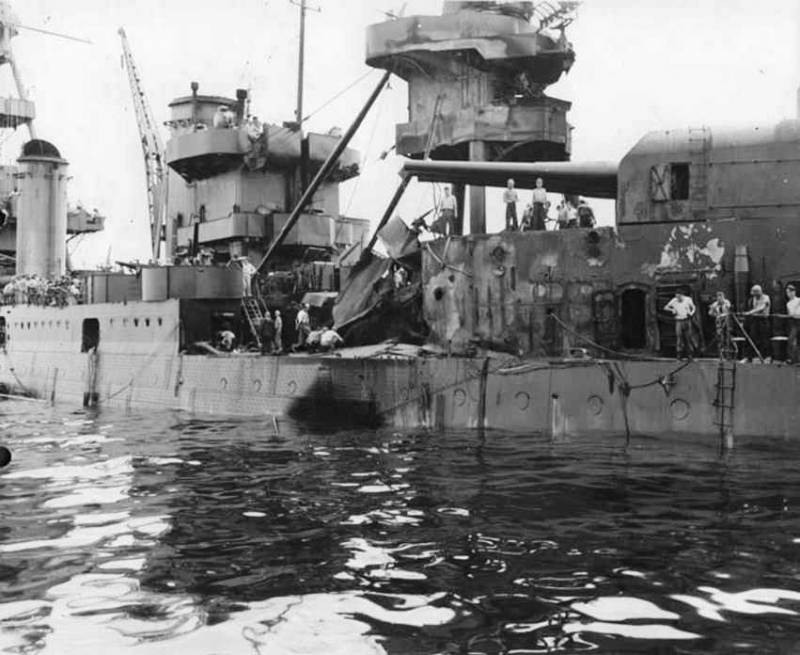Ironbottom Sound:
Battle of Tassafaronga, Part Two
by Mike Bennighof, Ph.D.
February 2025
 At 2140, the Americans entered Ironbottom Sound from the Lengo Channel, the southernmost of the three passages into the deadly waters from the eastern side, in a single column. Minneapolis guided them through the treacherous waters with her SG radar. At 2140, the Americans entered Ironbottom Sound from the Lengo Channel, the southernmost of the three passages into the deadly waters from the eastern side, in a single column. Minneapolis guided them through the treacherous waters with her SG radar.
Here they encountered an American convoy of three transports and five destroyers, exiting Ironbottom Sound via the same channel. That forced Task Force 67 to slow down to avoid narrowly avoid multiple collisions, and Halsey made things even more tangled by ordering two of the convoy’s escorting destroyers, Lamson and Lardner, to join Wright’s force.
That presented Wright, on his way to his first battle, with still more unnecessary headaches. He had no chance to meet the captains of the two destroyers and share his battle plans. And Lamson carried the commander of Destroyer Division Nine, Capt. Laurence “Abe” Abercrombie. “Abe” immediately became the Senior Destroyer Officer Present, and under the Navy’s strict Cult of Seniority, he should have supplanted Commander William Cole of Fletcher as commander of Wright’s destroyers. Wright solved the problem by ordering Abercrombie’s pair of destroyers to steam well behind his cruisers as “rear guard,” with the unspoken understanding that they should stay out of the way. Abercrombie managed to move them up onto Northampton’s left despite his orders.
“No information was obtained concerning the disposition of enemy forces,” Abercrombie wrote in his after-action report, “what might be encountered, no operation orders, no special instructions, no recognition signals, no reference or rendezvous points or anything pertaining to the night's operations.”
Once into the Sound, Wright put his four destroyers in front, with the five cruisers arrayed in line abreast behind them rather than the line ahead formation the Americans had deployed in the previous night actions. Flagship Minneapolis took the right-most spot, with New Orleans on her left followed by Pensacola, Honolulu, and Northampton.

At the same time that Wright’s task force entered Ironbottom Sound from the east, Tanaka did so from the north-west, passing Savo Island in line-ahead formation. Takanami led the column, followed by Oyashio, Kuroshio, Kagero, Makinami, Naganami, Kawakaze and Suzukaze.
Minneapolis made the first radar sighting at 2306, picking up two objects at a distance of 23,000 yards. The moon had not yet risen, low cloud cover made the night seem even darker, and the seas were preternaturally calm. Wright lifted all restrictions on radar use. The Japanese, meanwhile, made ready to started tossing their drums overboard. At 2312 Takanami reported “Enemy in Sight,” at a distance of 6,000 meters; within second the destroyer appended “seven enemy destroyers sighted.”
Tanaka promptly ordered “Close and Attack,” but his destroyers had already broken formation to drop off their supplies. Capt. Torajiro Sato of the 15th Destroyer Division led his three transport boats (Oyashio, Kuroshio and Kagero) into battle in formation, but each of the remaining Japanese boats leapt to the attack on its own. Most, but not all, steamed directly eastwards at speed, and then turned back to keep the range from opening as their courses diverged from those of the Americans.

Destroyer Kawakaze torpedoed and sank the heavy cruiser Northampton.
The American destroyers reported themselves in torpedo range at 2316, but not until 2319 did Wright give the order to launch their torpedoes. The battle plan had called for the American cruisers to open fire with their guns only after the torpedoes had reached their targets, but Wright ordered them to commence firing as well. All of the American torpedoes missed; only Naganami reported spotting and evading them.
Wright had sent his cruiser floatplanes to Tulagi before the battle, and planned for them to drop flares over the battle. With the enemy expected to be found close to the coastline, Wright worried that his radar operators would have trouble distinguishing ships from shore, and hoped the flares would help clarify things. But the planes had trouble taking off in the very calm water and did not arrive overhead until the battle had concluded. Without the flares, the American cruisers lobbed starshells into the night sky to illuminate the enemy.
The Japanese loosed 50 torpedoes from seven destroyers (Makinami does not appear to have launched any of hers, while Kagero launched just four and Kuroshio six of their eight). Kagero used her searchlights, but the other destroyers used the gun flashes of the American cruisers as their aiming points.

New Orleans arrives at Sydney, 3 January 1943.
As Wright had feared, radar could not clearly identify individual ships so close to Guadalcanal, and all of the cruisers had just one target: the hapless Takinami. Most of the American ships fired solely at Takinami, killing her skipper Masami Ogura and turning the boat into a flaming wreck. The Japanese destroyers, relying on highly-trained spotters, targeted their American counterparts as they made their escape.
At 2329, the big Type 93 oxygen torpedoes reached their targets. Since the Japanese had moved eastwards before launching them, Wright’s innovative line-abreast formation presented all five cruisers in a slightly staggered array before them. A torpedo that missed its first target still had four more cruisers that it might strike.
Minneapolis, the flagship, and New Orleans suffered the first hits. Two of the doomed Takanami’s torpedoes hit Minneapolis, crumpling her bow back to her first 8-inch turret and opening one of her firerooms to the sea. She’d fired two salvoes, with a third loaded and moments from firing when the ship lost all electrical power. Thirty-seven of her crew died, and Wright passed command to Rear Admiral Mahlon S. Tisdale aboard Honolulu.
New Orleans sheered away when the first torpedo struck Minneapolis, bringing her directly into the path of another torpedo, which hit underneath her forward 8-inch turret. The torpedo hit detonated the magazine, and 183 sailors died instantly, including brothers Edward, Jack, and Charles Rogers. Somehow the cruiser stayed afloat.
“We had four feet of water up there and I thought we’s gonna sink right then,” Gunner’s Mate (Third Class) James Gilbert Edwards recalled in 2003. “The ship it was, I mean, buckin’ and everything. We had the secondary explosion which blowed the bow off and it floated down beside the ship.”
Just as New Orleans had been forced to dodge the stricken Minneapolis, so did Pensacola turn abruptly away from New Orleans, again into the path of a torpedo, this one launched by Oyashio. Pensacola had fired two salvoes at what her spotters identified as a “Mogami-class cruiser” with three stacks, and the crew cheered as the enemy ship exploded, capsized, and sank. She turned out to be the light cruiser Honolulu, which Pensacola had not actually hit at all. The torpedo struck Pensacola directly under her mainmast, holing the engine room, knocking out three of her four turrets and igniting a massive fire which cooked off 5-inch and 8-inch ammunition.

PT109 brings survivors of Northampton to Tulagi on the morning after the battle. The damaged New Orleans is in the background.
Honolulu, screened by the wrecked and burning heavy cruisers, evaded torpedo hits. She did manage to open rapid fire on Abercrombie’s two trailing destroyers, when they flashed the wrong recognition signals (another problem Halsey should have foreseen).
Northampton, closest to the Japanese destroyers, suffered two torpedo hits at 2347. The fish, launched by Kawakaze, struck together amidships, igniting fires, and starting mass flooding. These could not be controlled, and she finally sank at 0304; her skipper, Willard A. Kitts, swam back to the sinking cruiser to rescue his steward, Francisco Macaraeg, who could not swim.
Northampton would be the only cruiser sunk, as vastly improved American damage-control procedures saved the other three from devastating torpedo hits that likely would have sunk all of them a year earlier. The three damaged cruisers limped to Tulagi for temporary repairs, before setting out for better-equipped locations (New Orleans steamed all the way to Sydney, backwards, with a temporary bow covering of coconut logs). On the Japanese side, Takanami was lost just off Guadalcanal with 197 of her crew; 48 made it to shore where 19 men would survive the campaign and go into American captivity.
At least some of the Japanese destroyers tossed their supply drums overboard, but it appears that few if any of these made it to shore. With the American heavy cruisers out of action and the American destroyers seeking survivors of Northampton and assisting the damaged cruisers, Tanaka had the opportunity to try again. Only his flagship carried torpedo reloads (the unfortunate Takinami sank without having the chance to fire her second set of fish) and Makinami may have still had her torpedoes. Instead, he chose to retire to Rabaul.
The Japanese believed that they had sunk “one Texas-class battleship” (Pensacola had a very similar profile to the older American battleships). But that did not bring any accolades to Tanaka. The Navy Department of Imperial General Headquarters, in its confidential assessment of the battle, found a great deal to criticize regarding Tanaka’s performance. He had placed his flagship in the center of the column, rather than at the front as tradition demanded. His flagship quickly fired her torpedoes and left the battle area; the Japanese success was due to the initiative and competence of the division and boat commanders. But worst of all, he abandoned his mission without delivering the desperately needed supplies.
“It is better to complete the transport mission,” the report read, “than to sink one or two battleships.”
Over time, Tanaka came to agree.
“It was an error on my part not to have delivered the supplies on schedule,” a weeping Tanaka told Capt. Tameichi Hara, the former commander of the destroyer Amatsukaze, in 1957. “I should have returned to do so. The delivery mission was abandoned simply because we did not have accurate information about the strength of the enemy.”

Pensacola, the morning after.
Despite Tanaka’s timid performance, the Battle of Tassafaronga was a stunning defeat for the U.S. Navy. For his part, Wright claimed in his after-action report that he had sunk four Japanese destroyers and damaged two others; the U.S. Navy’s public relations machine inflated that into a smashing victory, with seven destroyers and three transports sunk (more ships than were present on the Japanese side). Wright was awarded the Navy Cross to cover up the extent of the disaster and shuffled off to a shore command. He would return to sea in 1944 to command a cruiser squadron.
Tanaka returned three nights later, this time with ten destroyers, and again on the 7th with a dozen boats and for a final run on 11 December with 11 destroyers. After Tassafaronga, Halsey abandoned attempts to challenge the Japanese in Ironbottom Sound with surface ships, in large part because he had run out of them. Instead, Tanaka faced heightened air attacks, and opposition by PT boats. The American aircraft and motor torpedo boats waited for dawn to reveal the supply drums still floating on the waves, when they sank any drums that they found with machine-gun fire.
In the last run of the Tokyo Express, American PT boats sank Tanaka’s flagship, the destroyer Teruzuki, and Tanaka was wounded. In late December he was transferred to shore duty in Singapore and later in Burma, and never served at sea again.
The submarine transport efforts had been suspended with the loss of I-3 to a PT boat torpedo on 9 December; her sister I-2 was immediately recalled. On 12 December, the day after the last run of the Tokyo Express, the Navy formally recommended that Guadalcanal be abandoned.
Click here to join the Gold Club.
See your Gold Club Insider newsletter for ordering information.
Sign up for our newsletter right here. Your info will never be sold or transferred; we'll just use it to update you on new games and new offers.
Mike Bennighof is president of Avalanche Press and holds a doctorate in history from Emory University. A Fulbright Scholar and NASA Journalist in Space finalist, he has published a great many books, games and articles on historical subjects; people are saying that some of them are actually good.
He lives in Birmingham, Alabama with his wife, three children, and new puppy. He misses his lizard-hunting Iron Dog, Leopold.
Daily Content includes no AI-generated content or third-party ads. We work hard to keep it that way, and that’s a lot of work. You can help us keep things that way with your gift through this link right here.
|
